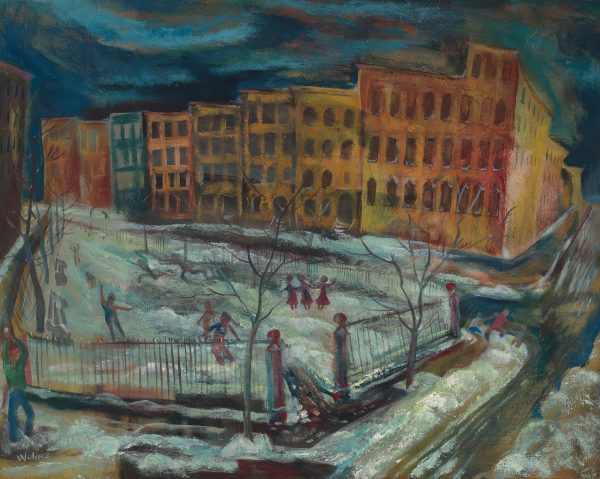
End of Scammel Street, The
Wolins, Joseph
1937–38
Artwork Information
-
Title:
End of Scammel Street, The
-
Artist:
Wolins, Joseph
-
Artist Bio:
American, 1915–1999
-
Date:
1937–38
-
Medium:
Oil on canvas board
-
Dimensions:
23 7/8 x 30 inches
-
Credit Line:
Wichita Art Museum, Museum purchase, Director's Discretionary Fund
-
Object Number:
1982.9
-
Display:
Currently on Display
About the Artwork
This painting titled The End of Scammel Street was executed in 1939 by the American artist Joseph Wolins. The setting is a small enclosed park on a narrow rundown street known as Scammel Street situated on the lower east side of Manhattan in New York City. Today, the park is covered with concrete, but during the Depression years it served as a playground for the near destitute children of the neighborhood.
Wolins chose this site as the subject of an extended series of paintings that he executed during the late 1930s while working under the Federal Arts Project of the WPA. He lived nearby and was fully acquainted with the dilapidated state of the neighborhood with its old 19th century row houses as seen in the background. And it was the shabbiness of the location, especially on a gloomy winter day when slush and dirty snow had accumulated on sidewalks and in the park, that so clearly echoed the depressive mood of the times. That mood is skillfully caught here but at the same time is balanced by the active play of children who run, chase and throw snowballs in the park.
Particularly striking are the strong compositional geometry and the interesting style, which Wolins has adopted. Lines and masses are so arranged that the eye is forcefully pulled across the park to a sharp arrow-like point at the far left. In turn that pull is balanced by the line of the broad, deserted street at the right as well as by the exaggerated tilt of the large apartment dwelling situated at the right corner of the house row seen in the background. Human figures are treated as silhouettes clearly resembling cardboard cut-outs. And the row of houses with its irregular roofline and dingy facades, black windows and dark and uninviting doorways seem mournfully forbidding. Moreover, that house row sags at each corner and appears about to tumble. Yet this work commands attention, for the energetic flow of pigment, the simplified and expressive forms and the muted color tones employed throughout combine to effectively communicate a sense of spirited optimism and aliveness in a setting which is otherwise grim and foreboding.
Wolins’ apparent interest in specifically conveying these opposing qualities rather typifies the attitudes of many Depression artists. For contrary to what we might expect, at the heart of American Depression painting, a note of optimism and hope is frequently widely experienced throughout the period.
Joseph Wolins was born in Atlantic City, New Jersey in 1915. He studied at the National Academy of Design from 1931 to 1935 and worked under the WPA Art Project from 1935 until 1941. He has exhibited widely throughout the United States and his works are in such collections as the Metropolitan Museum, the Butler Institute and elsewhere. He has been the recipient of numerous awards including the Mark Rothko Award, which he won in 1971. Wolins currently lives and paints in his studios in New York City.